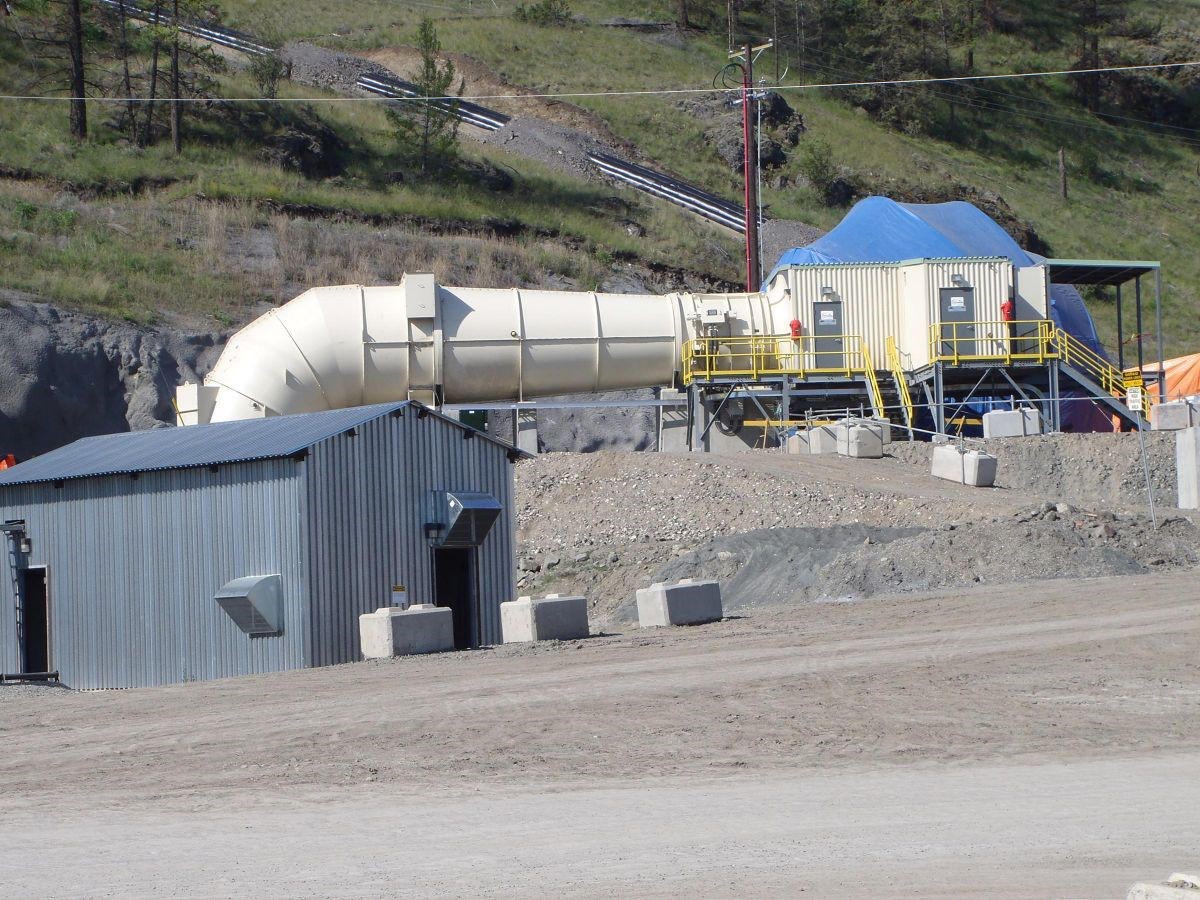Evaluating complex mine ventilation operational changes through simulations
DOI:
https://doi.org/10.17159/2413-3051/2018/v29i3a4445Keywords:
Mine ventilation networks;, Simulations;, Optimisation;, Sustainable cost saving.Abstract
Increasing the profitability of the mining industry is contingent on its ability to improve operational efficiency. Mine ventilation networks typically represent 25-50% of a mine’s energy consumption and, therefore, exhibits scope for optimisation. Ventilation networks comprise numerous complex integrated airways, branches and ventilation fans. The most effective way to optimise and evaluate them is computer-aided simulations. However, no framework exists to clarify exactly how operational changes in ventilation networks should be evaluated. In this study, a scalable method was developed, implemented and analysed. The case study validation resulted in satisfying key performance indicators of both service delivery and operational energy costs, thereby increasing operational efficiency. The significance of the novel method is that it allows for improved operational decisions on mine ventilation networks. The value of the method was illustrated by the adoption of the method by the case study mining personnel to form the new norm of their procedures and standards.
Downloads
References
Widiatmojo, A. Sasaki, K., Sugai, Y., Suzuki, Y., Tanaka, H., Uchida, K. and Matsumoto, H. 2015. Assessment of air dispersion characteristic in underground mine ventilation: Field measurement and numerical evaluation. Process Safety and Environmental Protection. Institution of Chemical Engineers, 93, pp. 173–181. doi:10.1016/j.psep.2014.04.001.
Pritchard, C. 2010. Methods to improve efficiency of mine ventilation systems. National institute for occupational safety and health, Spokane Research Laboratory (SRL), Washington, VA, pp. 1–5. Available at: https://stacks.cdc.gov/view/cdc/9913/cdc_9913_DS1.pdf.
Webber, R., Franz, R. and Marx, W. 2003. A review of local and international heat stress indices, standards and limits with reference to ultra-deep mining. Journal of the Southern African Institute of Mining and Metallurgy, 103(5), pp. 313–324. Available at: https://www.google.co.za/url?sa=t&rct=j&q=&esrc=s&source=web&cd=2&cad=rja&uact=8&ved=0ahUKEwjU5fGzqfjXAhUMWRoKHVB4DdsQFggwMAE&url=http%3A%2F%2Fjournals.co.za%2Fcontent%2Fsaimm%2F103%2F5%2FAJA0038223X_2862&usg=AOvVaw1S1AEfmOEQCUhQG8GrPRUz.
De Souza, E. 2015. Improving the energy efficiency of mine fan assemblages. Applied Thermal Engineering, 90, pp. 1092–1097.
doi: 10.1016/j.applthermaleng.2015.04.048.
Gomes, C. M., Kneipp, J.M., Kruglianskas, I., Da Rosa, L.A. and Bichueti, R.S. 2014. Management for sustainability in companies of the mining sector: an analysis of the main factors related with the business performance. Journal of Cleaner Production, 84, pp. 84–93.
doi: 10.1016/j.jclepro.2013.08.030.
Kaplan, D. 2012. South African mining equipment and specialist services: Technological capacity, export performance and policy. Resources Policy. Elsevier, 37(4), pp. 425–433. doi: 10.1016/j.resourpol.2012.06.001.
Kohler, M. 2014. Differential electricity pricing and energy efficiency in South Africa. Energy, 64, pp. 524–532. doi: 10.1016/j.energy.2013.11.047.
De Souza, E. 2007. Optimization of complex mine ventilation systems with computer network modelling. IFAC Proceedings Volumes. IFAC, 40(11), pp. 323–329. doi: 10.3182/20070821-3-CA-2919.00049.
Du Plessis, J. J. L., Marx, W. M. and Nell, C. 2014. Efficient use of energy in the ventilation and cooling of mines. Journal of the Southern African Institute of Mining and Metallurgy, 114(12), pp. 1033–1037.
Swart, C. 2003. Optimising the operation of underground mine refrigeration plants and ventilation fans for minimum costs. PhD dissertation, North-West University. Available at: http://repository.nwu.ac.za/bitstream/handle/10394/339/swart_c.pdf?sequence=1.
Chatterjee, A., Zhang, L. and Xia, X. 2015. Optimization of mine ventilation fan speeds according to ventilation on demand and time of use tariff. Applied Energy, 146, pp. 65–73. doi: 10.1016/j.apenergy.2015.01.134.
Roghanchi, P., Kocsis, K. C. and Sunkpal, M. 2016. Sensitivity analysis of the effect of airflow velocity on the thermal comfort in underground mines. Journal of Sustainable Mining, 15, pp. 175–180. doi: 10.1016/j.jsm.2017.03.005.
Maré, P. and Marais, P. J. H. 2017. Novel simulations for energy management of mine cooling systems. PhD dissertation, North-West University. Available at: https://www.google.co.za/url?sa=t&rct=j&q=&esrc=s&source=web&cd=1&cad=rja&uact=8&ved=0ahUKEwjb6f-UyebXAhXkKsAKHZaiD6QQFggoMAA&url=https%3A%2F%2Frepository.nwu.ac.za%2Fhandle%2F10394%2F25525&usg=AOvVaw3ugqpdgsH2pjk0uh3WvELO.
Yun, S. and Hai-ning, W. 2011. Study and Application on Simulation and Optimization System for the Mine Ventilation Network. Procedia Engineering, 26, pp. 236–242. doi: 10.1016/j.proeng.2011.11.2163.
Du Plessis, J.J.L., Hoffman, D., Marx, W.M., and Van der Westhuizen, R. 2013. Optimising ventilation and cooling systems for an operating mine using Network Simulation Models. Association of Mine Managers South Africa, pp. 1–16. Available at: https://www.google.co.za/url?sa=t&rct=j&q=&esrc=s&source=web&cd=7&cad=rja&uact=8&ved=0ahUKEwi577S6yubXAhXIDMAKHVwYB5YQFghTMAY&url=http%3A%2F%2Fwww.ammsa.org.za%2Fdownload-category%2Ffinish%2F1-technical-papers%2F1194-optimising-ventilation-and-cooling-sys.
Acuna, E. I. and Lowndes, I. S. 2014. A review of primary mine ventilation system optimization. Interfaces, 44(2), pp. 163–175.
doi: 10.1287/inte.2014.0736.
De La Vergne, J. 2014. Hard Rock Miner’s Handbook. 5th edn. Edited by S. L. Anderson. Edmonton, Alberta: Stantec Consulting. Available at: www.stantec.com/mining.
Panigrahi, D. C. and Mishra, D. P. 2014. CFD Simulations for the Selection of an Appropriate Blade Profile for Improving Energy Efficiency in Axial Flow Mine Ventilation Fans. Journal of Sustainable Mining. Elsevier Masson SAS, 13(1), pp. 15–21. doi: 10.7424/jsm140104.
Chauhan, V. 2014. Optimization of parameters to improve ventilation in underground mine working using CFD. M. Tech. dissertation, National Institute of Technology, ROURKELA. Available at: https://www.google.co.za/url?sa=t&rct=j&q=&esrc=s&source=web&cd=1&cad=rja&uact=8&ved=0ahUKEwjL0dnej-TXAhWEzRQKHa8nBlIQFggoMAA&url=http%3A%2F%2Fethesis.nitrkl.ac.in%2F6211%2F1%2FE-24.pdf&usg=AOvVaw2kihiKB2Xw1Tbn2jFhJAOP.
Mcpherson, M. J. 1984. Mine ventilation planning in the 1980s. International Journal of Mining Engineering, 2(3), pp. 185–227.
doi: 10.1007/BF00881111.
M.J. McPherson 1993. Subsurface Ventilation and Environmental Engineering.1st edn. Edited by M. McPherson. London, England: Chapman & Hall. doi: 10.1007/978-94-011-1550-6.
McPherson, M. J. 2015. Subsurface Ventilation Engineering. 1st edn. Edited by M. J. McPherson. London, England: Springer. Available at: https://www.scribd.com/doc/308462249/Subsurface-Ventilation-Engineering-McPHERSON.
Nel, A. J. H., Vosloo, J. C. and Mathews, M. J. 2018. Financial model for energy efficiency projects in the mining industry. Energy, 163, pp. 546-554. doi:https://doi.org/10.1016/j.energy.2018.08.154.

Downloads
Additional Files
Published
Issue
Section
License
Copyright (c) 2018 Andries J.H. Nel, Jan C. Vosloo, Marc J. Mathews

This work is licensed under a Creative Commons Attribution-ShareAlike 4.0 International License.



.png)